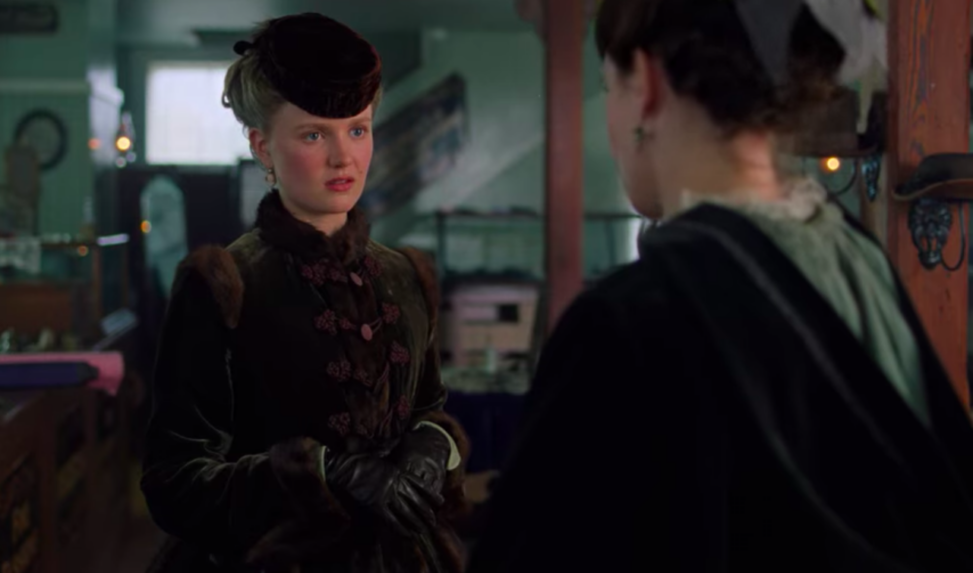Although she’s only in the film for a short amount of time, and is played by a relatively unknown actress, the “rich girl” character Sallie Moffat still manages to cause a momentary stir in the 2019 film adaptation of Little Women, and act as a brief but worthy antagonist to main character, Meg March, who is played by “Harry Potter” starlet Emma Watson (Gerwig; IMDB). The 19th century story, Little Women, is a coming-of-age story about the Marches, a very poor but loving family from Massachusetts, who do their best to look out for each other while their father is fighting in the Civil War (Alcott). Although the Marches live under occasionally harsh circumstances, they don’t let it get to them often, as they are so kind-hearted, generous, and creative, they’re able to thrive with the support of their family and ingenuity. Meg March is a proud member of this family, and she’s played brilliantly in the film by Emma Watson, who’s gained celebrity for playing earnest and well-intentioned characters from beloved book adaptations (IMDB). Enter Sallie Moffat, who, described in the screenplay as a “rich young woman who possesses an air of casual boredom”, is the literal opposite of Meg, both in character, as she is neither broke, nor generous, and in celebrity, as Hadley Robinson, the actress who plays her, has only been in a handful of small TV and movie roles (Gerwig 9; IMDB). Hadley’s role in Little Women is no exception, as Sallie is not a fleshed-out character, but rather a simple “sharp-edged” personality with the function of representing everything Meg is not (Straw 80). However, as small as Sallie’s character may be, she still manages to serve an important purpose, as she tempts Meg into faltering and prioritizing the allure of status over the humbling nature of her family (Gerwig). In every scene she’s in, Sallie momentarily overshadows Meg and makes her smaller in both emotional terms and, to quote Alex Woloch’s discussion on the minor character The One vs. The Many, in her position in the character system. The most notable example of this, is when Meg feels insecure at a ball due to not having a fancy dress like Sallie and their other rich friends. In this moment, there’s an interesting reversal of roles, as Meg, a main character, who’s on-screen presence is boosted by her actress’s “star persona”, becomes the unimportant one amongst the array of “extras” and “bit players”, including Sallie, who take up a large presence in this specific societal setting (Straw 79). This moment causes Meg to doubt, and feel lesser than the others, and it’s only when Laurie, a friend of the Marches, questions Meg’s actions and dances with her, that Meg’s presence blooms and returns to the normative of a main character, while Sallie returns to her small character space and essentially, minor-ness as a literary character (Gerwig).
Works Cited
“Emma Watson.” IMDb, IMDb.com, https://www.imdb.com/name/nm0914612/.
Gerwig, Greta, director. Little Women, Columbia Pictures, 2019.
Gerwig, Greta. Screenplay of Little Women. Script Slug, https://www.scriptslug.com/assets/scripts/little-women-2019.pdf
“Hadley Robinson.” IMDb, IMDb.com, https://www.imdb.com/name/nm6044874/.
Alcott, Louisa May. Little Women. Roberts Brothers, 1869.
Straw, Will. “The Small Parts, Small Players Dossier Introduction.” SCREEN, vol. 52, no. 1, Mar. 2011, pp. 78–81. EBSCOhost, https://doi-org.ezproxy.tru.ca/10.1093/screen/hjq057.
Woloch, Alex. The One Vs. The Many : Minor Characters and the Space of the Protagonist in the Novel. Princeton University Press, 2003. EBSCOhost, https://search-ebscohost-com.ezproxy.tru.ca/login.aspx?direct=true&db=nlebk&AN=286709&site=eds-live&scope=site.

Provide Feedback